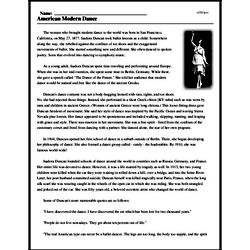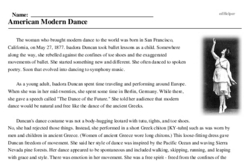American Modern Dance
Isadora Duncan's Birth Date
Reading Comprehension for May 27
The woman who brought modern dance to the world was born in San Francisco, California, on May 27, 1877. Isadora Duncan took ballet lessons as a child. Somewhere along the way, she rebelled against the confines of toe shoes and the exaggerated movements of ballet. She started something new and different. She often danced to spoken poetry. Soon that evolved into dancing to symphony music.
As a young adult, Isadora Duncan spent time traveling and performing around Europe. When she was in her mid-twenties, she spent some time in Berlin, Germany. While there, she gave a speech called "The Dance of the Future." She told her audience that modern dance would be natural and free like the dance of the ancient Greeks.
Duncan's dance costume was not a body-hugging leotard with tutu, tights, and toe shoes. No, she had rejected those things. Instead, she performed in a short Greek chiton [KY-tuhn] such as was worn by men and children in ancient Greece. (Women of ancient Greece wore long chitons.) This loose-fitting dress gave Duncan freedom of movement. She said her style of dance was inspired by the Pacific Ocean and waving Sierra Nevada pine forests. Her dance appeared to be spontaneous and included walking, skipping, running, and leaping with grace and style. There was emotion in her movement. She was a free spirit - freed from the confines of the customary corset and freed from dancing with a partner. She danced alone, the star of her own program.
In 1904, Duncan opened her first school of dance in a suburb outside of Berlin. There, she began developing her philosophy of dance. She also formed a dance group called - cutely - the Isadorables. By 1910, she was famous world-wide!




